
by Joshua Criss | Mar 18, 2022
A Problem of Anticipation
The feeling is palpable, everyone is ready for spring. Can you hear them? The seeds beckoning in their packets, begging you to bury them in the soil. Every gardener struggles with this dilemma in early spring, but this year will surely be different. Maybe just maybe I can get my garden planted and watch with bated breath as life peeks its tiny shoots through the soil. Inevitably, harsh reality will set in with the realization that there will be a freeze dowsing your dreams before they take root.
Trying as that may be there is a respite. A small group of plants has heard your concerns. They provide the early spring color we so desperately seek in our landscapes. The trees and shrubs have answered your cries reaching out in the most beautiful way they know how. The saucer magnolias (Magnolia x soulangeana) have given us their teacup flowers all purple and perfect. The azaleas (Rhododendron spp.) are in full swing with all their magnificence shining bright. There is one tree that stands above them all in Florida landscapes. This month you’ll begin to see a tree that is the ultimate harbinger of springtime. A tree so native in the Panhandle that it bears the state’s name within its own. The tree I am speaking of is the Flowering Dogwood (Cornus florida).
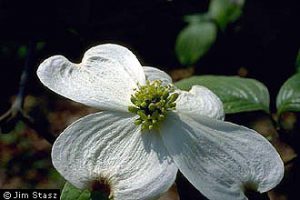
Dogwood flower and bracts in bloom. Photo Credit Jim Stasz, USDA
A Tree Described
Florida in this instance derives from the Spanish florido meaning “full of flowers”. This tree will not disappoint on this front. A very common home landscape feature, it performs well in zones 5-9A. Growing between 20-30 feet in height with the spread to match, they may be pruned to a single trunk or allowed to grow in multiples to fit the landscape. This tree is known for early spring color, and thrives in sun of shade. Sometime between March and May, a splash of white or pink (sometimes red, cultivar dependent) lasting several weeks will rear up amid your winter scenery.
The showiness of this plant is not a flower, but a protective leaf structure known as a bract. The true flowers are small yellow to green clusters in the center of these bracts. Depending on the site conditions, the foliage turns maroon and the flowers to red berries in the autumn. The spring flowers, and later berries are a useful food source for pollinators and local birds respectively.
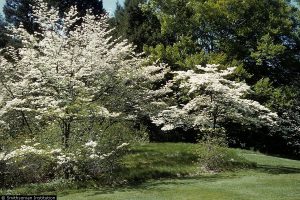
Dogwood trees in the wild. Photo Credit Smithsonian Institution
More Information
Flowering Dogwoods is a valuable addition to any gardener’s plot and fits right into a Florida Friendly Landscape. For more information on these trees, see this Ask IFAS document, or contact your local extension agent for additional information on this and any topic regarding your gardens and more.
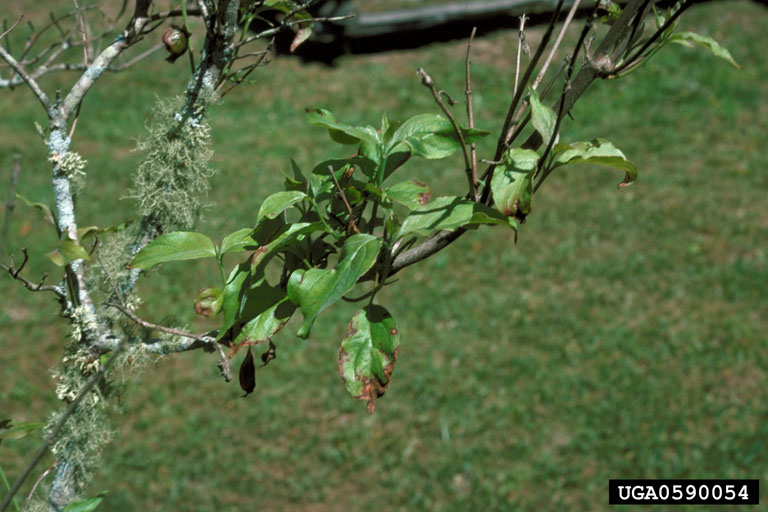
by Daniel J. Leonard | Mar 29, 2017
Everyone, or at least everyone fortunate enough to grow up in the South, has a fond memory tucked away of a sight or smell of a plant that reminds them of the good old days. Maybe it’s the ancient camellia at your grandmother’s house that just feels like home when you see it. Maybe it’s a persimmon tree with fruit weighing on the branches, the smell of baked persimmon bread cooling in the kitchen close behind. For me and countless others, it’s the sight of the iconic native flowering dogwood (Cornus florida) blooming each spring in the understory of Panhandle forests. However, if you’ve been paying attention, the spring dogwood bloom has diminished with each passing year, leaving many folks wondering what happened. As with many things, the answer is multi-faceted and complicated.
First, as homeowners who have grown dogwoods for many years are well aware, dogwoods are notoriously susceptible to harsh site conditions. In the landscape setting, much of the difficulty in growing dogwoods may be attributed to Florida’s frequent extended droughty periods and improperly citing the trees in a full-sun location. dogwoods naturally prefer a cool, moist root zone and protection from the hot afternoon sun; failure to provide such a setting will most likely lead to scorched-appearing foliage, overall poor performance and a short-lived tree.
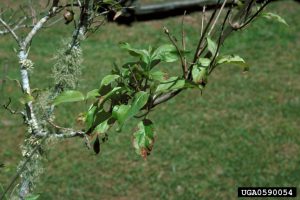
Various Dogwood Leaf Spots
More problematic are the many diseases dogwoods are prone to, including several fungal leaf spots, cankers and mildew diseases, all of which impair their ability to create energy and store the needed nutrients to survive tough periods (frequent droughts). All of these diseases are much more problematic in the unseasonably warm, wet winters and cool, wet springs Floridians have been experiencing with regularity over the last decade. It is good practice to actively clean up any fallen, diseased leaves as well as to prune out any obviously dead or diseased wood to prevent problems from spreading further, but total suppression of these diseases is impractical for most homeowners.
As if all of those problems weren’t enough, the most sobering issue currently facing flowering dogwood is a fungal disease known as dogwood anthracnose (Discula destructiva). D. destructiva has been confirmed responsible for the decline of dogwoods in more upland areas around the foothills of the Appalachians and has been surmised to have moved south into the coastal plain, although its presence in our area has largely been undocumented. As with other pathogens, disease incidence is increased in already stressed trees as well as in mild, wet-weather conditions in the spring and fall. Symptoms of D. destructiva usually begin with purplish spots on the margins of leaves in early summer, with infected leaves hanging onto the tree through winter. The disease then spreads down through the tree and manifests itself as a sort of dieback of twigs and limbs, eventually forming cankers and killing the tree.
As dire as the dogwood situation may seem, there are some potential solutions. First, if you must plant a flowering dogwood, make sure you give it an ideal situation. Irrigate when rainfall is inconsistent, apply a layer of an organic mulch (pinestraw, wood chips, etc.) at a depth of 2”-3”, and plant in a protected, shady situation. If growing a native dogwood might seem too challenging, there is a related species from Asia called kousa dogwood (Cornus kousa) that deserves to be planted more. Kousa dogwood is not a perfect tree but it retains most everything we love about native dogwoods without the disease issues!
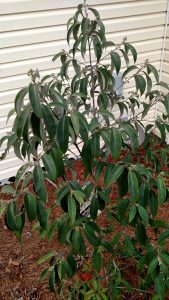
Young ‘Empress of China’ in the author’s lawn.
Kousa’s retain the classic creamy white flowers, attractive berries in fall, and layered branching (called sympodial branching) of our native dogwoods but also bring a few extra attributes to the table. Kousa dogwood grows to a rounded 15’-20 in height and width, is much more tolerant of cultural extremes than flowering dogwood and is resistant to the various diseases that plague native dogwoods. Also, there is a subspecies of kousa dogwood, Cornus kousa var. angustata that is even evergreen in our area, no more barren limbs in the winter! The most popular selection of this subspecies is a beautiful little tree being marketed as ‘Empress of China’ through the southern living plant collection; I am currently trialing this tree in my yard and it has impressed so far.
So to wrap up, if the decline of the dogwoods has you down, there are three things you can do:
- Give your existing dogwoods some TLC, keep them well-watered in droughty periods and mulch to keep the roots cool.
- Cut out any dead or diseased branches in existing dogwoods and rake and dispose of leaves from previous years that are lying around.
- If you want to plant a new dogwood, try a kousa dogwood (Cornus kousa) as this species is a more than adequate replacement for Cornus florida!
As always, consult your local UF/IFAS Extension Office with any questions or concerns you have regarding your landscape and happy gardening!






